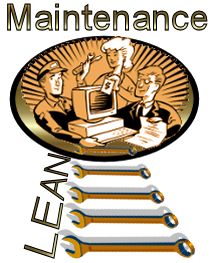Be a LEAN Maintenance Black Belt!
- Home >
- articles >
- maintenance-management >
- lean maintenance
Why Are There No Six Sigma Black Belts in Your Lean Maintenance Department?

Lean Maintenance Management
The LEAN Maintenance Six Sigma Black Belt article explores why there are so few Six Sigma black belts in Six Sigma maintenance departments. In the manufacturing future, there will be fewer humans and more automation, thus focusing more on lean maintenance management.
Ever-increasing automation and the need for Six Sigma maintenance reliability that capitalizes on lean maintenance principles and practices will bring about the Six Sigma black belt jobs in the maintenance department. Just like relatively recently, maintenance planner jobs have sprung up. The first phase of this evolution will most likely be Six Sigma black belts as maintenance managers. Then, the industry will realize that effective lean maintenance management requires maintenance technicians to get Six Sigma black belt training.
Now is the time to explore barriers to why there are No Six Sigma Black Belts in your Lean Maintenance department.
- Six Sigma training drives newly minted black belts into a consulting role. Six Sigma green belts in industrial maintenance, which become black belts, are then rotated between corporate departments and travel among work sites. While a 6 Sigma black belt or TPM professional works on problems in the industrial maintenance department, black belts are deemed too valuable to focus only on industrial maintenance. Hence, it is rare to find a black belt in industrial maintenance unless it is for a narrowly focused project.
- Initially, industrial maintenance staff like mechanics, maintenance technicians, and electricians received no Six Sigma or advanced TPM training. Only when Six Sigma professionals realized that the best ideas came from those on the front lines and the production received Six Sigma training in yellow and white belt courses did they start to reach those outside the office. There is still no widespread recognition of the value of training industrial maintenance black belt professionals.
- Industrial engineers who complete Six Sigma certifications, TPM training, and TPM certification often graduate to full-time management instead of remaining in the industrial maintenance group. Advanced certifications become management tickets instead of improving the industrial maintenance group.
- Industrial maintenance management may be its own department. More often than not, it is part of the engineering department. In these cases, maintenance managers are the second tier in the engineering department. They put out fires, literally and figuratively, while engineers focus on designing new production facilities or radically revamping existing ones. More thought needs to be put into applying 6 Sigma concepts and predictive models to maintenance while implementing them on the production line.
- When there are Six Sigma experts or TPM consultants in the facility, they tend to focus on production rather than maintenance, despite the dramatic cost savings an improved facility maintenance and asset management can bring. A professional with TPM certification is often brought in as a temporary consultant with a few grand ideas like redesigning maintenance procedures and work order processes and implementing data collection. They also put channels in place so that good ideas and problem reports reach management on time.
- Maintenance planning and scheduling are more often based on a calendar than the number of hours the equipment has run. Maintenance is shifted to accommodate human schedules. Managers schedule work to minimize overtime or force staff to work over the Christmas holidays. There is a failure to optimize the cost of ongoing maintenance against the reduced risk of equipment failure and its extended operational life.
- Process improvement projects in the industrial maintenance area need data that can be used to make decisions. However, the necessary records to properly plan the labor hours for maintenance and repairs may be lacking. There may be a partial accounting of the critical skill sets essential for maintenance. More people may be assigned to the task than required to ensure the necessary skill sets are all present, and work may still take longer than planned when the one person who knows how to complete a job is busy. When paper forms are used for repair work orders, managers fail to capture the environmental variables that may have caused the failure.
- Statistical process control and run charts have become standard on the shop floor. Employees regularly record vital metrics and report any deviating trends toward management. While industrial maintenance planning and scheduling software has come out, it focuses on scheduling people and tools rather than metrics on how long each team takes to perform the work. While industrial maintenance planning and scheduling software has come out, it focuses on scheduling people and tools rather than metrics on how long each team takes to perform the work. Correlating information such as which maintenance procedures and personal variations of these work practices result in faster turnarounds and more extended operating periods may be a painful manual exercise compared to an SPC chart analysis.
- When there are too many outages and shutdowns, preventative maintenance too often falls by the wayside. Unfortunately, there is little expertise in identifying methods to move from a reactive maintenance environment to a preventative one short of hiring far more maintenance staff or replacing used equipment with new equipment.
- Plant managers and maintenance supervisors who have risen to this level from the maintenance department rarely have statistical training, such as 6 Sigma training, and adopt predictive maintenance.
Related Training ...
Autonomous Maintenance Training Program (Phase II)
Total Productive Maintenance Management Course - TPM PowerPoint [PowerPoint's]
OEE - Total Productive Maintenance Objectives - TPM Tool [eBook]
True Down Time Costs Analysis - ROCE accounting [eBook]
Next Article ...
Total Productive Maintenance definition, married to TPM
Don Fitchett - Business Industrial Network (BIN) - BIN95.com
|
